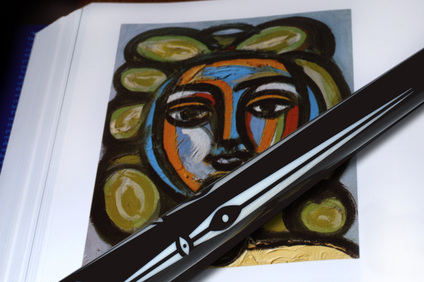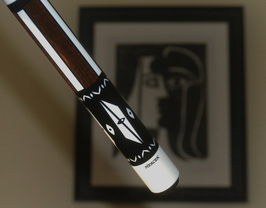
Built in 2007, the "Eyes of Picasso" was built by commission from collector Deno J. Andrews. Andrews, an avid collector of Hercek's work, asked that the cue be inspired by the works of Pablo Picasso. Hercek is adamantly against taking other artists designs and reproducing them in his cues. Andrews doesn't like to micro-manage the cue design process. He prefers to give a cue maker a theme or genre, a budget, and let the cuemaker have total control over the end result. This relationships resulted in an ivory-handle masterpiece appropriately named "Eyes of Picasso" as the inlay elements of the cue were inspired by the ubiquitous almond-shaped eyes in Picasso's work.
Joel Hercek learned the art of cue making from the late master Burton Spain, who
specialized in building full-splice blanks, with four points and veneers. Hercek continues that tradition today, and every cue he makes has the full-splice construction. However, when looking at this cue, no spliced points are visible. The reason is that in certain art- themed cue sticks, the traditional look of four spliced points with veneers is not desired. Since Hercek will not make a cue that is not a full splice, which he (and many others) believes is the best way to splice cue parts together, he remedies this problem by placing an ebony sleeve over an existing full splice. That means that despite the appearance of inlaid ivory points for decoration, the insides of the cue contain the core construction belief
that has made Hercek's cues some of the most sought after cues today.
Joel Hercek learned the art of cue making from the late master Burton Spain, who
specialized in building full-splice blanks, with four points and veneers. Hercek continues that tradition today, and every cue he makes has the full-splice construction. However, when looking at this cue, no spliced points are visible. The reason is that in certain art- themed cue sticks, the traditional look of four spliced points with veneers is not desired. Since Hercek will not make a cue that is not a full splice, which he (and many others) believes is the best way to splice cue parts together, he remedies this problem by placing an ebony sleeve over an existing full splice. That means that despite the appearance of inlaid ivory points for decoration, the insides of the cue contain the core construction belief
that has made Hercek's cues some of the most sought after cues today.

The forearm begins above alternating long boxes of solid ivory and snakewood. All inlay material is pre-treaty ivory and finished by hand. Inlays are finished so that corners and points come to a razor-sharp edge, a detail unobtainable by machines. Points that are inlaid in the forearm feature two eyes that contrast each other with alternating pupil colors of black and white. The almond shape is referenced as the point components traveling up the forearm wrap around the vertical eye. Homage is paid to Picasso's use of black and white and playful use of contrasting shapes and space. Alternating boxes in the handle area introduced a third and subtle color to the cue's otherwise black-and-white palette. Snakewood is a fickle wood with which to work. Splitting and cracking are common attributes that make working with Snakewood frustrating to cue makers. Manipulating pieces as long and large as these proved to be time consuming for Hercek. The color and texture of the Snakewood was initially a design risk because black-and-white cues do not commonly have other colors. In this cue stick though, the color and texture of the Snakewood is subtle enough to act as a compliment, but audacious enough to be in the style of Picasso, and Hercek.
The butt section is beneath another section of alternating boxes. Again, contrasting eye elements of alternating color are visible with every other eye being framed inside large geometric shapes. The butt section itself is framed by alternating geometric shapes. The butt cap is solid ivory with the name "Hercek" engraved. The joint is also ivory and its configuration is a 5/16" screw piloted construction. There are two shafts, neither of which were ever chalked.
The butt section is beneath another section of alternating boxes. Again, contrasting eye elements of alternating color are visible with every other eye being framed inside large geometric shapes. The butt section itself is framed by alternating geometric shapes. The butt cap is solid ivory with the name "Hercek" engraved. The joint is also ivory and its configuration is a 5/16" screw piloted construction. There are two shafts, neither of which were ever chalked.
